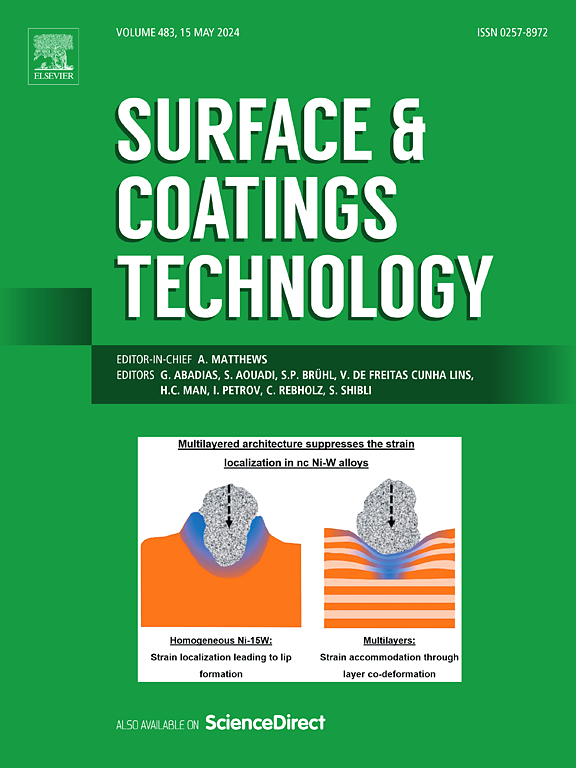Formation of the polycrystalline structure in the interdiffusion zone of a PtAl-coated third-generation SX superalloy
IF 5.3
2区 材料科学
Q1 MATERIALS SCIENCE, COATINGS & FILMS
引用次数: 0
Abstract
The polycrystalline structure of the interdiffusion zone (IDZ) significantly affects the mechanical properties of the PtAl-coated single crystal (SX) superalloys, while its formation mechanism has not been clarified yet. This study systematically investigated the formation of the polycrystalline structure in the IDZ of a PtAl-coated third-generation SX superalloy by analyzing the interdiffusion and microstructural evolution during the coating deposition process, which mainly consists of grit blasting, Pt electroplating, interdiffusion at 900 °C, and aluminizing. The results indicated that the polycrystalline structure in the IDZ was formed during interdiffusion between the Pt plating layer and the SX superalloy, and was determined by the diffusion rather than the grit blasting. Notably, the phase transformation from cuboidal γ/γ’ phases to Pt-rich γ1/γ’1 phases with irregular shapes occurred in the IDZ during interdiffusion at 900 °C, and the phase boundaries and grain boundaries between the IDZ and the SX superalloy coincided. The formation of the polycrystalline IDZ was mainly attributed to the grain boundary (GB) migration induced by the phase transformation, similar to the discontinuous precipitation. Specifically, Pt diffused from the nano-crystalline Pt-plating layer to the SX superalloy mainly along the GBs, inducing the nucleation of Pt-rich γ1/γ’1 phases at the GBs. Subsequently, γ1/γ’1 phases grew in the direction of Pt diffusion, and the GBs migrated along the growth direction of γ1/γ’1 phases concurrently. This study will be helpful for reducing the formation of the polycrystalline structure in the IDZ of the PtAl-coated SX superalloy.
ptal涂层第三代SX高温合金扩散区多晶结构的形成
扩散间区(IDZ)的多晶结构对ptal包覆单晶高温合金的力学性能有显著影响,但其形成机制尚未明确。本研究通过分析涂层沉积过程中喷砂、镀Pt、900℃互扩散、渗铝等过程的相互扩散和显微组织演变,系统研究了ptal涂层第三代SX高温合金IDZ中多晶结构的形成。结果表明,多晶结构是在镀Pt层与SX高温合金相互扩散过程中形成的,由扩散作用而非喷砂作用决定。值得注意的是,在900℃时,IDZ发生了由立方体γ/γ′相向形状不规则的富pt γ1/γ′1相转变,且IDZ与SX高温合金的相界和晶界重合。多晶IDZ的形成主要是由于相变引起的晶界(GB)迁移,类似于不连续析出。其中,Pt主要沿GBs向SX高温合金扩散,在GBs处形成富Pt的γ1/γ′1相形核。随后,γ1/γ′1相沿Pt扩散方向生长,而GBs同时沿γ1/γ′1相生长方向迁移。本研究将有助于减少ptal涂层SX高温合金的IDZ中多晶结构的形成。
本文章由计算机程序翻译,如有差异,请以英文原文为准。
求助全文
约1分钟内获得全文
求助全文
来源期刊

Surface & Coatings Technology
工程技术-材料科学:膜
CiteScore
10.00
自引率
11.10%
发文量
921
审稿时长
19 days
期刊介绍:
Surface and Coatings Technology is an international archival journal publishing scientific papers on significant developments in surface and interface engineering to modify and improve the surface properties of materials for protection in demanding contact conditions or aggressive environments, or for enhanced functional performance. Contributions range from original scientific articles concerned with fundamental and applied aspects of research or direct applications of metallic, inorganic, organic and composite coatings, to invited reviews of current technology in specific areas. Papers submitted to this journal are expected to be in line with the following aspects in processes, and properties/performance:
A. Processes: Physical and chemical vapour deposition techniques, thermal and plasma spraying, surface modification by directed energy techniques such as ion, electron and laser beams, thermo-chemical treatment, wet chemical and electrochemical processes such as plating, sol-gel coating, anodization, plasma electrolytic oxidation, etc., but excluding painting.
B. Properties/performance: friction performance, wear resistance (e.g., abrasion, erosion, fretting, etc), corrosion and oxidation resistance, thermal protection, diffusion resistance, hydrophilicity/hydrophobicity, and properties relevant to smart materials behaviour and enhanced multifunctional performance for environmental, energy and medical applications, but excluding device aspects.
 求助内容:
求助内容: 应助结果提醒方式:
应助结果提醒方式:


